Way back in 2005, I was living in a spartan two-bedroom apartment with my girlfriend, our cat, and my best friend in the entire world. We didn’t have much: a couple of beds, a ratty couch, a TV, a whole mess of books packed into a couple of second hand shelves, and two souped-up computers. We also had a Playstation 2 (PS2) which didn’t see much play. But when God of War (GOW) entered the picture, that all changed.

At the time, GOW pushed the PS2 hardware to its very limits. With groundbreaking graphics, stellar gameplay, and fantastic storyline, it was easy to become totally infatuated with the game. It was, hands down, the best video game I had ever played. I recall thinking at the time that it would take considerable effort to create a video game that completely captured me the way that GOW did.
Then, a few years later, Santa Monica Studio released God of War 2. It was even better than the first. And it wasn’t until that moment that I realized Santa Monica Studio had set a (dangerous?) precedent for themselves. With the first GOW, they’d set the bar really high. With GOW2, they not only leapt over that bar, but they set themselves another impossibly high one. In doing so, they set the expectation that with each and every new entry into the franchise, they’d outdo themselves—and they have. The God of War games have just gotten consistently better and better as the years have gone by.
Because of that, I know what I’m getting when I dive into a new GOW experience. Santa Monica Studio has shown me that I can always rely on them to strive to break the bounds of their own limitations, to bring to fruition a product that exceeds all expectations, and to provide an unforgettable experience.
When it comes to tabletop games, that’s the way Garphill Games makes me feel. Just when I think they’ve hit their zenith and couldn’t possibly get even better, they pull it off. They drop a Wayfarers of the South Tigris bomb on you and walk coolly and confidently away from the explosion in slow motion while sliding on a pair of shades.
To say that I like this game would be an understatement. I love it. And I’m going to tell you why.
But first, let’s talk a little about the game, its goals, and how it all works. If none of that interests you, feel free to skip ahead to the Thoughts section.
Overview
Simply put, Wayfarers of the South Tigris (Wayfarers) is a dice-driven worker placement and action selection game—where your workers are represented by dice—with a healthy dose of tableau building thrown in to boot. The end goal is to score the most victory points, and these can be earned in a myriad of different ways.
At the start of each round, the players roll their personal supplies of dice and then take turns assigning those dice to perform various actions. The tricky part is that the only action locations capable of accepting dice are in the players’ personal tableaus. The other actions that dot the borders of the main board can only be carried out through traditional meeple-based worker placement actions, and these exist within a closed economy. Each player begins the game with a single yellow and a single blue meeple. Later, as players cross certain thresholds, there are four green meeples that will enter the economy— and that’s it. The only way to reclaim meeples that have been played to the main board is via tableau building.
Acquiring cards and adding them to your tableau will not only potentially net you meeples, but they will also provide you with more powerful dice placement locations, bonus scoring potentials, and end-game scoring opportunities. Of course, there are various rules and limitations in place that dictate when, where, and how dice and workers can be used, but we’ll get to all of that shortly. Suffice to say, Wayfarers is a game with a great deal of options and having to weigh the costs and benefits of choosing one over the other is where the game’s challenge—and its fun—lies.
Setup
The central game board is divided into three double-sided segments. Any of the various sides can be used. After selecting these and arranging the three segments side by side, the outer edges of the board are surrounded by cards randomly drawn from their matching decks: Townsfolk in the top left; Space cards in the top right; Inspiration cards along the rightmost edge; Water cards along the bottom right; and Land cards along the bottom left. The center of the board comprises the Journal track that is divided into boxes connected by ink blots. Several of these boxes are empty and are filled with randomly placed Journal tiles. The green worker meeples are placed into their marked locations on this track as well. There are also locations for the various Upgrade tiles (pink, green, black, blue, and yellow). Place these atop their matching pictures.

Each player selects a color and receives the pieces in their chosen color. Two of their three dice are placed into the guild area of the main board along with some influence tokens (the locations of and amount placed are dependent on playing order). Their player marker is placed onto the first space of the Journal track. Then they each receive a randomly distributed player board along with some starting provisions, some cash, one yellow worker, and one blue worker. Their remaining three dice are rolled and placed close by.
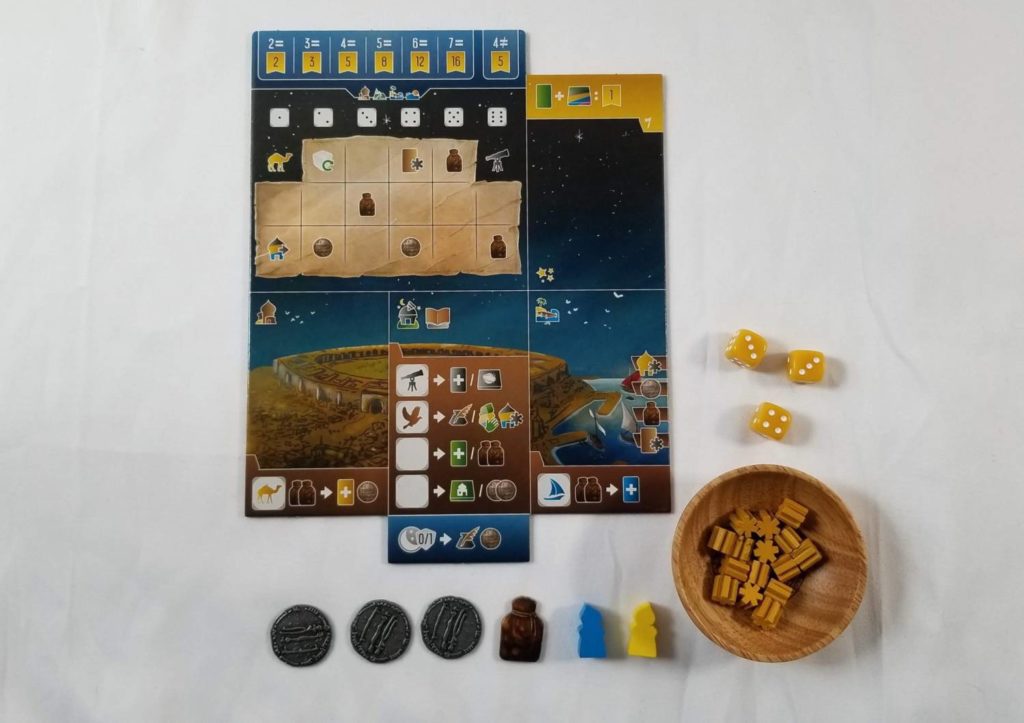
Now, select a starting player and you’re ready to begin.
Taking Turns
Wayfarers is played over a number of rounds until at least one player’s marker reaches the final space on the Journal track. At that point, every player, including the one that triggered the end game, receives one final turn. Then the points are tallied to determine the winner.
On a player’s turn, they can do one of three things: place a worker onto the main board and perform the action associated with its space, place a die into their tableau to perform the action associated with its space, or Rest. Resting consists of collecting any Rest bonuses before reclaiming and rerolling your dice. While similar in description, the other two options are different enough that they bear some further discussion.
Main Board Actions
Each different card type situated around the main board has four action spaces associated with it. In order to take one of these actions, a player must place a worker matching the color of the action onto the card that is physically situated next to the action being taken. If any player has an influence on the card, the person placing the worker must pay that player either a coin or a provision. If they’re unable to, they cannot take the action. Furthermore, they cannot take the action if a worker meeple is already present that matches the color of the worker meeple they’re wanting to use.
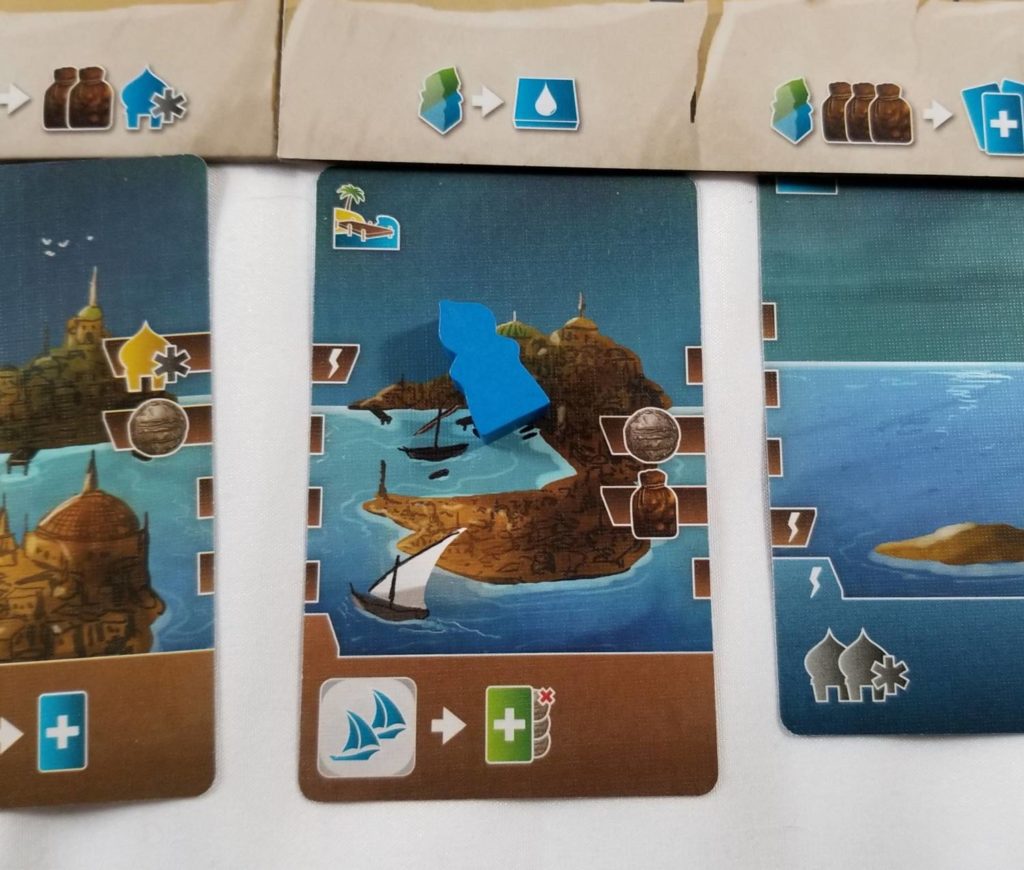
In general, these actions are used to: acquire the various card types, place influence into the various guilds, acquire Upgrade tiles (which we’ll talk more about shortly), manipulate dice, or gain coins/provisions… or some mixture of these options.
Tableau Actions
Each player board consists of a caravan (broken into three rows and six columns, several pre-printed cards (some featuring action spaces), and a central column of even more pre-printed action spaces. These action spaces are presented as white squares, which indicates they can accommodate a die. However, some of these white spaces feature an icon. In order to place a die onto one of these locations, that die must have an association with the icon in question or you must have access to the required tag somewhere outside of your caravan.
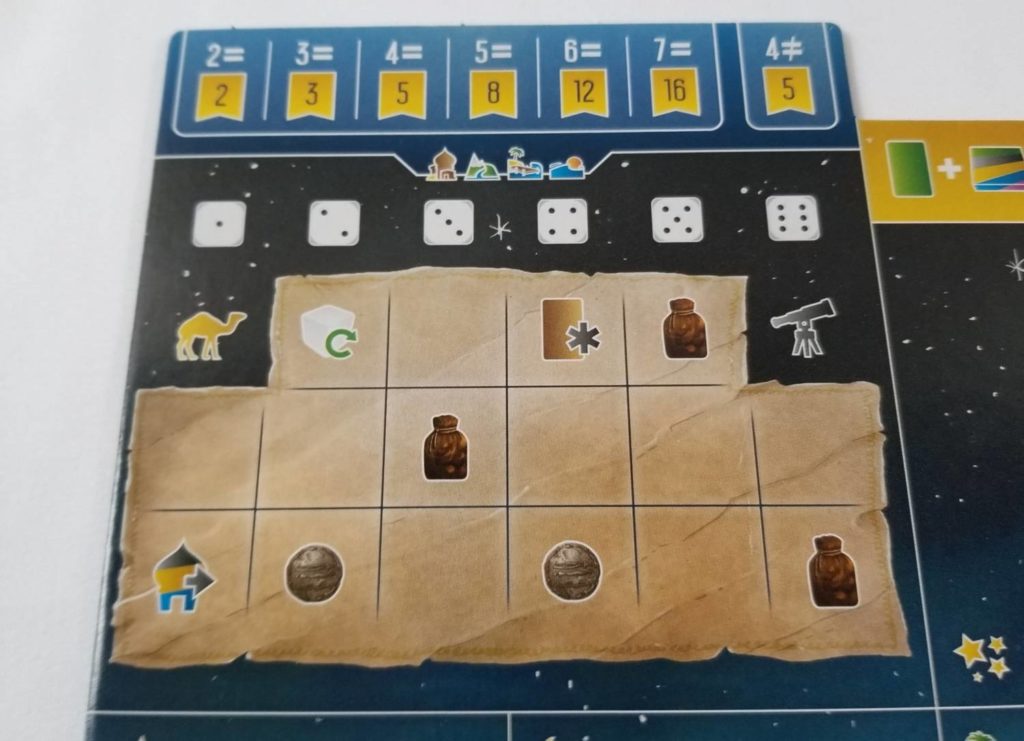
To better understand all that, let’s take a second to talk about the caravan and tags.
At the top of each column of the caravan, there is the image of a die with a different pip value. The spaces beneath that image represent the die’s tag associations. If you’re familiar with Terraforming Mars (or its spin-off, Terraforming Mars: Ares Expedition) then the concept of tags will, no doubt, already be familiar to you. In those games tags act as a sort of currency, but they’re never actually spent. They just have to be present in order for certain things to happen. In the case of Wayfarers, tags are closely tied to three things: tableau actions, adding to your tableau, and endgame scoring.
Here’s how it works: Let’s imagine you’re wanting to take the topmost action shown on your player board. This action location features the icon of a telescope. In order to place a die on that action, there must be a telescope icon in the column matching the pip value of the die you’re wanting to place there.
At the beginning of the game, the only die value that features this icon is a six. Later, through the addition of Upgrade tiles, you can add new icons to these rows and columns, providing you with new options and greater flexibility. Some of these upgrades simply provide you with end-game points or additional tags. There are even upgrades that you can add that will allow you to manipulate your dice by increasing/decreasing their value.
Building Your Tableau
Your tableau consists of three main types of cards—Space, Land, and Water—as well as the cards that are used to improve them—Townsfolk and Inspiration. These cards are acquired using the different board/tableau actions that are available. Land cards are attached to the bottom left of the player board, Water to the bottom right, and Space cards along the top left or right.

Land cards are subdivided into two groups, Cities and Vistas. Cities add new action locations to your tableau, whereas Vistas provide the players with benefits for acquiring other items during the game. These can be modified by sliding Townsfolk cards beneath them. Townsfolk cards placed beneath Cities enhance the action space of the card they’re attached to. Townsfolk placed beneath Vistas enhance the bonus provided whenever the criteria are met.
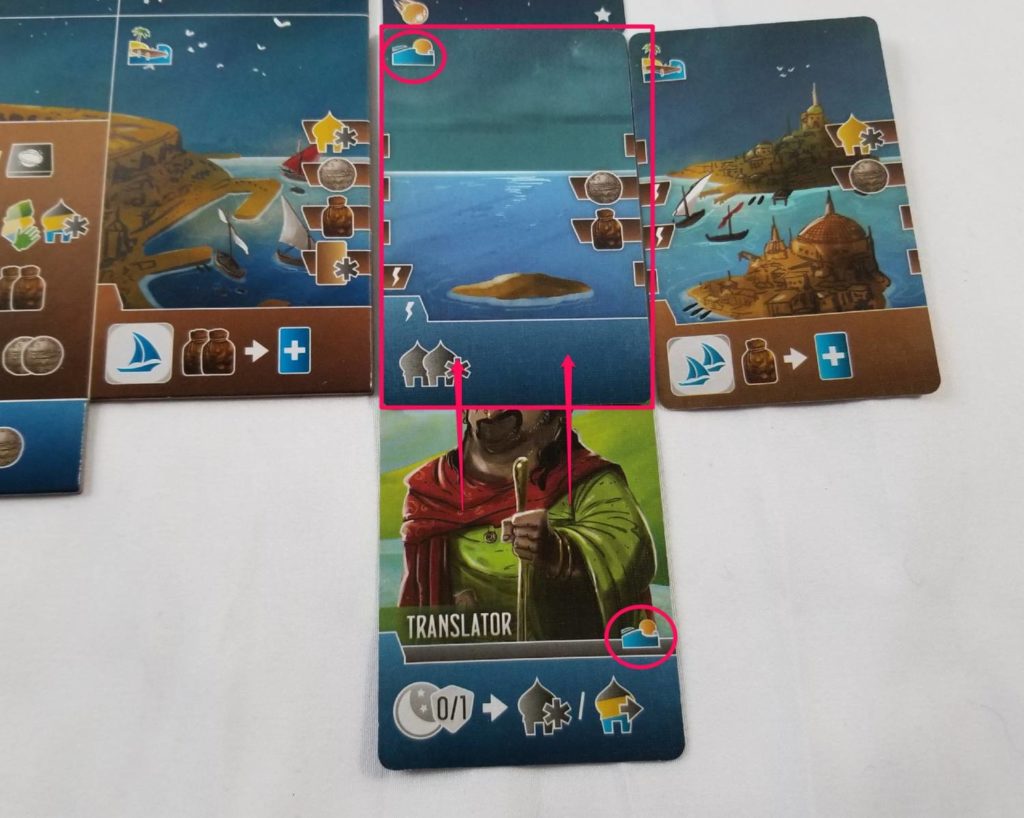
Water cards are also subdivided into two groups: Harbours and Open Waters. Harbours provide players with even more action locations, while Open Waters provide players with immediate, one-time benefits. These cards can also be modified by sliding Townsfolk cards beneath them. Townsfolk cards placed beneath Harbours enhance the action of the card they’re attached to. Townsfolk placed beneath Harbours improve the effectiveness of your Rest action. Additionally, Water cards feature some iconography running up and down the left and right sides of the cards. Matching these together with other cards in just the right way will earn their owner immediate bonuses.

Space cards provide end-of-game scoring bonuses. These can be modified by sliding Inspiration cards beneath them. Each Inspiration card has a requirement printed on it. If this requirement is met by the end of the game, then the Inspiration card will double the amount of points earned by the Space card it is attached to.
And There’s Even More
By this point, you should have enough context to understand how Wayfarers is played, but there are a couple more things you should be aware of.
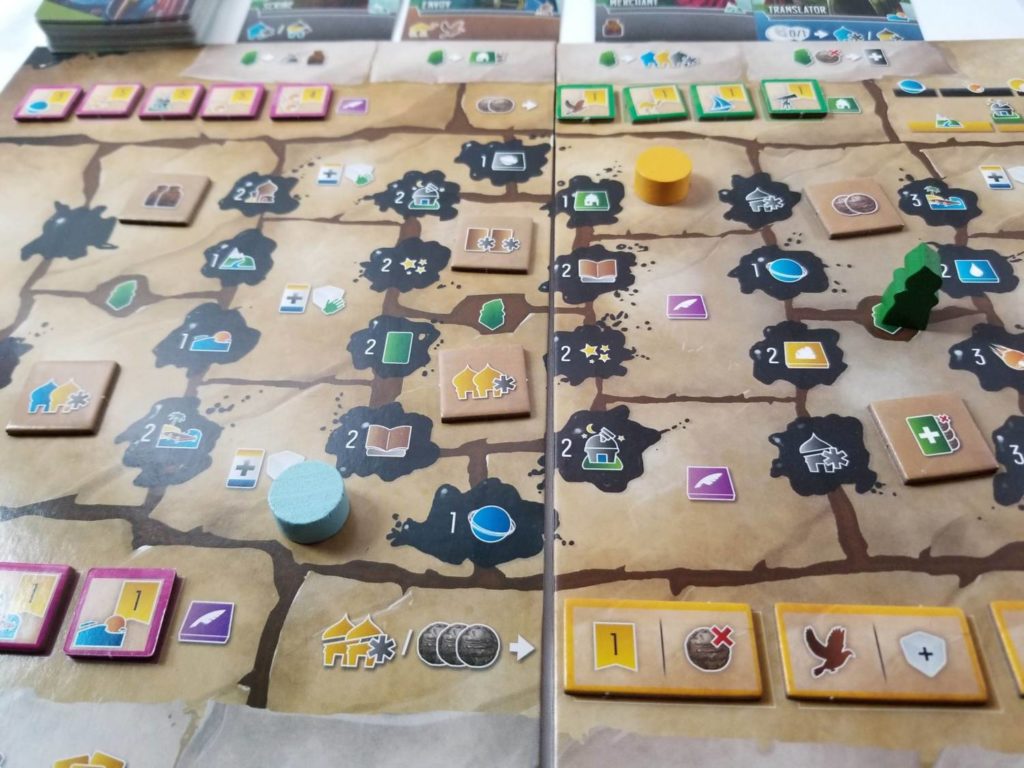
For starters, there’s the Journaling action. Taking this action allows you to progress your marker along the Journal track on the main board. Each box on the board is connected to others via ink blots. Some ink blots have specific requirements that need to be met in order for your marker to pass over them and into the next box. And almost every box has some kind of bonus that a player moving their marker to that space will receive. The bonuses vary, but they include things such as: placing influence, getting free cards, gaining resources, earning free caravan upgrades, etc. Importantly, this Journal movement is the only way to gain Inspiration cards.

Then there are the guilds. On the right side of the main board are three minarets representing three different guilds: black, yellow, and blue. During the game, players will have opportunities to add their influence markers to these. This is important for two reasons. First, there is an end-of-game scoring component tied to influence majority in each different guild. Second, at any time during a player’s turn, players can remove their influence markers from the guilds in order to perform that guild’s unique bonus action. Black allows you to perform an additional Journaling action in addition to a Journaling action you’ve just performed. Yellow gives you the ability to manipulate your dice. Blue provides a temporary ‘ship’ tag, useful for performing actions that require this icon if none of the columns in your caravan feature it.
Scoring
Once the game has reached its conclusion, scores are tallied to determine the winner. Victory points come from several places:
- Having collections of different tags
- Having collections of the same tags
- Space cards (modified by completed Inspiration cards)
- Points printed on caravan upgrades
- Guild influence majorities
Ties are broken in favor of who has the most influence in the black guild, followed by the yellow, followed by the blue. There is no score pad provided, a misstep in my opinion, but Garphill Games does have a stellar scoring app which is available for both iOS and Android.
Thoughts
For many people, October 31st represents a day of fun, dressing up in costume, and consuming their body’s weight in candy. Last year, as my wife and son were getting excited about Halloween, I was getting excited for an entirely different reason. Garphill Games had something big they were going to be announcing on a livestream later in the day. I’m pretty ambivalent about Halloween, but I’m definitely not ambivalent to Shem Phillips. I was dying to know what the hubbub was all about. This was a livestream I definitely was not going to miss.
What followed was an hour-long presentation of Garphill Game’s plans for their upcoming trilogy, beginning with a thorough discussion of Wayfarers of the South Tigris. By the time that hour was finished, I was sold. I knew that I needed this game in my life.
As it turns out, I was not wrong.
Wayfarers captures your attention before you’ve even cracked the lid on the box. I’ve expounded on it before, but it bears repeating: The Mico’s artwork is just amazing. His box cover illustrations have a way of pulling you in and getting you hyped about whatever’s hidden inside. But the proof, as they say, is in the pudding. Putting lipstick on a pig doesn’t make it any less of a pig. Wayfarers is no pig, unless pig is an acronym for “Pretty Impressive Game”. In which case, yeah, it’s definitely one of those.
Now, some people may ding Wayfarers as being a multiplayer solitaire experience and treat that as some kind of negative, and that’s a fair point. There isn’t much player interaction. So, if that’s a thing that bothers you, then Wayfarers probably isn’t the game for you. And, if you’ve got very limited physical space in which to play your games, then you’ll probably want to avoid Wayfarers for that reason as well. It’s a massive, sprawling endeavor, especially when you start adding more players. But, if you’re not put off by either of those factors, then Wayfarers is a game you should definitely be taking a look at. It’s got three important things that work in its favor: lots to do, lots to look forward to, and lots to look back on.
Lots to do: Wayfarers is a rich tapestry of interwoven mechanisms. On any given turn, even with just three dice at your command and a limited array of workers, you’re presented with a plethora of different options. Unlike some other games where you’ve got a choice between one or two good options and a lot of subpar ones, almost every option in Wayfarers is a really good one, which makes the act of selecting just one not easy. Every decision becomes just as important as every other decision. Wayfarers is, if anything, a game of efficiency. Finding the best path from A to B is a delicious, mind-bending puzzle without an obvious solution. Even deciding when to Rest becomes nail biting. Do you Rest as soon as you’re able so that you can regather your dice? Or do you do what I usually do (and not always to my advantage) and milk your turn for all its worth until Resting becomes the only viable move that you have left?
Lots to look forward to: The combination of the Journal track and the Space/Innovation cards creates a dynamic where, on top of trying to manage your needs in the here and now, a lot of your focus is on the future. If you can’t progress along the Journal track, you’re not going to do well. That progression requires a lot of advance planning. You’ll find yourself trying to pick out a path in your mind that you believe you can feasibly follow, using one space’s bonus to pay for progression to the next. And if you can get that to line up with the requirements of your Space/Innovation cards… then *chef’s kiss*. This focus on the future is the heart of Wayfarers and it feels amazing when the plan you’ve created in your mind is executed to perfection, even if it doesn’t lead to a win.
Lots to look back on: The true testament of a great game is that you find yourself reflecting on it in a positive light days, weeks, or even months after having played it. And that’s the type of game that Wayfarers is. I constantly find myself looking back on previous plays thinking about how I could have done things better while simultaneously appreciating those things that I did right. In this game I grabbed a lot of Space cards, which I wasn’t sure about and consequently wasn’t able to complete. In that game, I grabbed just a few and knocked them out of the park. And in that other game, I focused a great deal of effort on upgrading my caravan, but maybe I should have used some of that effort on something else. This constant state of reflection makes you pine for the game and that makes it extra exciting each and every time it hits your table.
If Wayfarers of the South Tigris is any indicator of what is to come for the rest of this trilogy, then know this: I am VERY excited. And, if past performance is any indicator of future performance, Garphill Games has their work cut out for them. In my humble opinion, Wayfarers of the South Tigris is the best game they’ve ever produced in all of their Medieval trilogies (as Garphill Games refers to them). It’s going to be hard to top it, but I believe Garphill Games is up to the challenge.





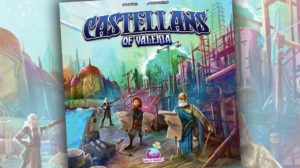






Add Comment